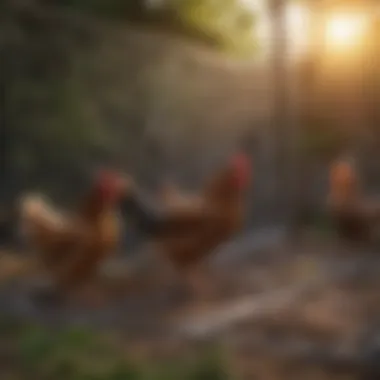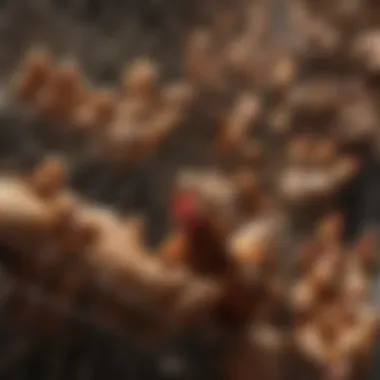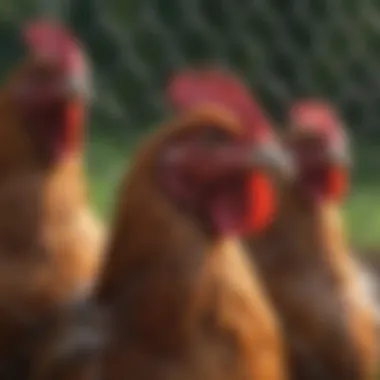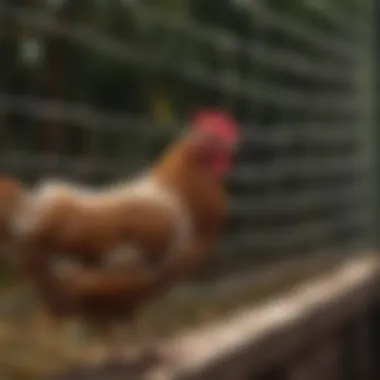Understanding Poultry Netting: Essential Guide for Owners


Intro
Poultry netting plays a critical role in the management of poultry farms. Its primary function is to protect birds from predators while facilitating their enviromment. As the poultry industry continues to evolve, understanding the nuances of netting becomes essential. This article will address various aspects of poultry netting, including types, applications, installation, and maintenance.
We will explore the importance of proper netting systems in improving the welfare of poultry while safeguarding them from possible hazards. This understanding is vital for anyone involved with poultry, ensuring they can choose the right solutions tailored to their specific needs and circumstances.
Types of Poultry Netting
Poultry netting comes in various forms, each crafted for specific purposes. Common types include:
- Hog wire fencing: Ideal for grazing and general protection.
- Electric netting: Provides a safe barrier while deterring predators effectively.
- Mesh netting: Lightweight and flexible, suitable for temporary enclosures.
When selecting netting, it is essential to consider the unique environment and requirements of your poultry operation.
Installation Methods
Proper installation of poultry netting is critical for its effectiveness. The following steps can help ensure a secure setup:
- Identify the area to be enclosed.
- Clear the ground of obstacles and debris.
- Stake down the netting firmly to prevent animals from burrowing under.
- Regularly check the integrity of the netting following installation.
These methods allow for better and more effective barriers against potential threats.
Maintenance Practices
Like any farming equipment, poultry netting requires regular maintenance. Key activities include:
- Inspecting for damages and repairs to maintain strength.
- Cleaning to avoid the build-up of dirt or algae, which can compromise visibility.
- Adjusting height or tension if sagging occurs over time.
With diligence and care, poultry netting can serve effectively for many years, providing essential protection for the poultry under care.
“Proper netting is an investment in the long-term health and safety of your poultry.”
Finale
Understanding poultry netting is crucial for effective poultry management. Careful selection, installation, and maintenance contribute significantly to ensuring the safety of the birds and promoting their overall well-being. With the right knowledge, poultry owners can create an environment where their birds thrive.
Preamble to Poultry Netting
Poultry netting plays a crucial role in the domains of poultry management and animal welfare. It is a critical aspect for those who raise birds, protecting them from potential threats. Understanding this netting helps owners optimize the health and security of their flocks.
Definition and Purpose
Poultry netting refers to a type of fencing used to enclose poultry in a designated area. The main objective is to provide a safe environment for the birds. It prevents predators, such as foxes or hawks, from accessing the flock. Additionally, poultry netting helps to keep the birds within a controlled area. This enclosure is not only about safety, but it also supports the overall well-being of the birds by allowing them to roam freely in a protected space. Owners selecting poultry netting should consider various aspects like the material, height, and intended purpose of the netting.
Historical Context
The use of netting in poultry farming is not a new concept. Historically, different cultures have utilized similar fencing techniques to protect their livestock. For instance, in ancient agrarian societies, rudimentary fencing made of natural materials was employed to keep poultry safe from wild animals. As farming practices evolved, so did the methods of protecting poultry. With advancements in materials and technology during the 20th century, the netting became more specialized. Today, there is a wide range of netting options available, tailored to meet specific needs of modern poultry farms. Through careful selection and application, poultry netting continues to be instrumental in promoting animal welfare and efficient farming practices.
Types of Poultry Netting
Understanding the types of poultry netting is crucial for poultry owners focused on creating a safe and conducive environment for their birds. Each type of netting has unique features, benefits, and limitations that impact its effectiveness in various settings. Selecting the appropriate netting can protect poultry from predators, ensure their well-being, and even promote natural behaviors. In this section, we will discuss three primary types of poultry netting and their respective advantages and considerations.
Plastic Netting
Plastic netting is a popular choice among poultry owners for several reasons. First, it is lightweight and relatively inexpensive compared to other types of netting. This makes it accessible for small-scale poultry keepers who want to safeguard their birds without significant financial burdens. The plastic material is durable enough to withstand various weather conditions, reducing the need for frequent replacement. Moreover, its visibility allows poultry to see through, encouraging them to roam and explore their environment safely.


However, there are some key points to keep in mind. Plastic netting may not offer the same level of strength as other materials. For instance, larger predators like raccoons or coyotes might chew through it if they are determined. Thus, while it provides basic protection, it may not be suitable for areas with heavier predator pressure. Regular inspections are essential to ensure it remains intact and functional.
Metal Wire Netting
Metal wire netting is another widely used option, known for its robustness and strength. Made from galvanized steel or other metals, this type of netting provides enhanced protection against both aerial and ground predators. Its sturdy construction can effectively keep out raccoons, foxes, and even larger birds of prey. This makes it an attractive solution for serious poultry operations or farms located in areas with high predator activity.
Nonetheless, metal wire netting can be more expensive to install and maintain. It requires proper installation techniques to ensure it remains secure and effective. Additionally, metal netting can pose injury risks to the birds if the edges are not properly finished. Thus, while it offers excellent protection, metal netting demands careful consideration regarding costs and bird safety.
Electric Netting
Electric netting represents a modern solution to poultry protection. It uses a series of charged wires to deter predators and can be incredibly effective in keeping animals at bay. Electric netting is designed to give a mild shock to any animal that attempts to breach the barrier, thus discouraging them from approaching the flock. Many poultry owners have reported success using electric netting, particularly in open areas where other forms of netting may be less effective against adaptable predators.
However, there are crucial factors to consider before choosing electric netting. First, it requires a source of power, whether battery or solar, which adds to initial costs. Moreover, the setup can be more complicated, necessitating attention to detail during installation. Additionally, it is critical to ensure the safety of the birds. If not set up properly, electric netting can also pose risks to poultry. Routine checks of the battery and wires are essential to maintain efficiency, making it a more hands-on option compared to other netting types.
The choice of poultry netting should align with the specific needs of your flock and the environmental conditions surrounding them. Understanding the advantages and disadvantages of plastic, metal wire, and electric netting will help you make a more informed decision to protect your birds effectively.
Benefits of Using Poultry Netting
Understanding the benefits of using poultry netting is crucial for anyone involved in poultry management. This section explores the specific advantages that netting offers. By installing proper netting, poultry owners can enhance the welfare of their birds significantly.
Protection from Predators
One of the primary reasons for utilizing poultry netting is protection from predators. Many environments pose risks to poultry from various animals, including raccoons, foxes, and birds of prey. Effective netting can create a physical barrier, denying access to potential threats. This is particularly important for free-range systems where birds are outside in natural settings.
Quality netting is designed to withstand attacks and can last for several seasons if properly maintained. Some netting materials deter larger animals while others are effective against smaller pests. This layered protection significantly reduces the risk of poultry loss due to predation, ensuring a safer environment.
Encouragement of Natural Behavior
Poultry netting also plays a vital role in encouraging natural behavior among birds. When poultry feel secure, they are more likely to exhibit instincts such as foraging and nesting. Netting allows for a safe space where birds can roam and explore without the constant fear of external threats.
Access to outdoor environments not only promotes physical health but also encourages social interactions among the flock. A well-structured netting system can foster improved mental well-being, as hens, for instance, can scratch the ground and engage in natural behaviors they typically would in more open settings.
Enhanced Biosecurity
Another advantage of poultry netting is enhanced biosecurity. Properly installed netting acts as a barrier that limits access to wild birds and mammals which may introduce diseases. Keeping pathogens away from poultry is essential for maintaining herd health.
By protecting birds from outside influences, netting contributes to lower veterinary costs and healthier flocks. Biosecurity is especially important in the poultry industry, where disease outbreaks can result in significant financial loss. Owners who invest in adequate netting are more likely to see long-term benefits through healthier poultry and reduced disease incidences.
Netting not only protects poultry but also contributes to their overall behavioral health and biosecurity, making it a multifaceted solution for poultry management.
In summary, the benefits of using poultry netting are profound. These include crucial protection from predators, the encouragement of natural behaviors, and enhanced biosecurity. Focusing on these benefits while selecting and installing netting is essential for ensuring that flocks remain healthy and thrive.
Disadvantages of Poultry Netting
When considering poultry netting, it's crucial to understand its disadvantages. While poultry netting serves various important functions, it also has shortcomings that chicken owners must be aware of. Understanding these factors helps in making informed decisions regarding poultry management. This section will cover initial cost considerations and durability issues, enabling you to weigh the pros and cons effectively.
Initial Cost Considerations
The initial costs associated with purchasing poultry netting can be significant. Various factors contribute to this financial outlay, including the type of netting, its size, and the installation process. For instance, electric netting may require additional investment in a charger and possibly more maintenance. Meanwhile, durable metal wire netting tends to be pricier than its plastic counterparts.
You must also consider the cost of installation. Many poultry netting systems require professional setup, which adds to the overall expense. Moreover, if you plan to cover a large area, the costs escalate quickly. Budgeting for these expenses before committing to a particular type of netting is essential for sustainable poultry farming.
It is also worth noting that some cheaper alternatives may lead to higher long-term costs due to repairs or replacements. Thus, while the upfront costs may be daunting, evaluating the long-term financial implications will provide better clarity.
Durability Issues


Durability is another critical aspect when it comes to poultry netting. Some types of netting, like plastic, are more susceptible to wear and tear from environmental elements. UV rays, rain, or even the constant pecking from the birds can lead to quicker degradation. This not only affects the functionality of the netting but also its lifespan, leading to the need for more frequent replacements.
On the other hand, metal wire netting is usually more robust. However, it can still pose challenges, such as rusting or bending, if not maintained properly. Additionally, if exposed to extreme conditions, its longevity can be compromised. Maintaining proper care can mitigate these issues but often demands time and effort.
Selecting the Appropriate Netting
Choosing the right poultry netting is a crucial decision for any poultry owner. This selection directly impacts not only the safety of the birds but also their overall health and productivity. Understanding different factors can lead to a more informed selection process. Proper netting can reduce predator attacks, prevent birds from escaping, and contribute to a stress-free environment.
Factors to Consider
When selecting poultry netting, several important factors must be taken into account:
- Size of the Flock: The number of birds will influence the amount of netting required as well as the kind of enclosure needed for their protection. A larger flock may require more robust netting.
- Predator Threats: Identify the types of predators in the area. If larger predators like raccoons or coyotes exist, stronger and more durable netting is essential.
- Poultry Type: Different birds may require specialized netting. Layers, broilers, and free-range birds each have unique needs in terms of space and security.
- Cost: Analyze your budget for netting options. Some materials offer long-term profiles at a higher initial cost, while others may be cheaper but require more frequent replacements.
- Ease of Installation: Consider how complex the installation process is. If your skills are limited, opting for simpler netting options is advisable.
These factors help guide owners toward netting that enhances safety and performance, enabling healthier poultry management practices.
Assessing the Environment
Assessing the environment where poultry netting will be installed is equally important. Several elements establish how well the netting will perform:
- Geographical Location: Terrain and weather patterns influence what types of netting are suitable. For instance, stronger netting may be necessary in regions prone to harsh weather.
- Existing Structures: Take note of barns, trees, or other physical attributes around the farm. This recognition aids in properly tailoring netting setups to maximize efficiency.
- Predator Patterns: Understanding local wildlife behavior can help determine the best type of netting. Identify when predators are most active and adapt netting accordingly.
- Accessibility: Determine how often you need to access the birds and area under netting. This fact can influence the design and type of netting to use.
Recording these environmental factors ensures that the selected poultry netting not only protects the birds but also complements the overall management system effectively.
Installation Techniques for Poultry Netting
Effective installation techniques for poultry netting are critical to ensuring the safety and well-being of the birds. Proper installation not only protects the poultry from predators but also enhances their natural behavior. This section will cover key elements of preparation and planning as well as a step-by-step installation guide, equipping poultry owners with the necessary knowledge to execute this important task efficiently.
Preparation and Planning
Before installing poultry netting, proper preparation and planning is essential. Assessing the specific needs and conditions will make a significant difference in installation outcomes.
A few important considerations include:
- Site Selection: Choose a location that provides suitable space for the poultry to roam while also ensuring that any potential hazards are minimized. Keep in mind terrain, sunlight exposure, and drainage.
- Netting Type Determination: Identify the type of netting most appropriate for your situation. This decision should be informed by the challenges present in the area, such as specific predators like raccoons or hawks.
- Measurements: Accurately measure the area to cover with netting, ensuring you have enough materials to complete the task. Always purchase a bit extra to account for mistakes or future expansions.
- Tools and Materials: Gather the necessary tools, including stakes, posts, and the netting itself. Understanding the required tools will streamline the installation process.
In this stage, creating a detailed plan can also help in visualizing how the installation will be carried out, as well as pinpointing any obstacles that may arise.
Step-by-Step Installation Guide
Follow these steps for a successful installation of poultry netting:
- Mark the Perimeter: Use stakes or flags to outline the area where the netting will be installed. This visual guide will assist in ensuring that the installation is conducted accurately.
- Install Posts: Begin by placing sturdy posts at strategic intervals around the perimeter. The spacing between the posts can depend on the netting type. For heavier netting, closer spacing is advisable.
- Attach the Netting: Once the posts are installed, begin unrolling and fastening the netting to the posts using appropriate fasteners. Pull the netting taut to prevent sagging, which may allow predators to penetrate the enclosure.
- Secure the Bottom: Bury the lower edge of the netting a few inches into the ground or attach it securely to stakes. This helps to deter digging pests like foxes or dogs from entering.
- Check for Gaps: After installation, thoroughly inspect the entire setup. Look for any gaps or weaknesses where predators could enter. Ensure that the netting is flush against the ground and that there are no loose or unsecured areas.
- Final Inspection: Conduct a final check once everything is in place. Tighten any loose parts and ensure that the structure is safe for the poultry.
By adhering to this step-by-step guide, poultry owners can effectively install netting, bolstering the protective barriers around their birds. Properly executed installation ensures peace of mind for the poultry owner and enhances the comfort and safety of the poultry.
Always remember, a well-installed netting system is a crucial line of defense against the threats faced by your poultry. Awareness and preparation are key to safeguarding your investment in poultry care.
Maintenance of Poultry Netting
Maintenance of poultry netting is crucial to ensure the safety and health of your birds. Neglecting this aspect could lead to potential risks such as predator attacks or injury to the poultry. Regular maintenance helps to prolong the life of the netting, ensuring that it continues to serve its primary function effectively.
Ensuring a well-maintained netting system contributes to the overall well-being of poultry. This can prevent common issues that arise when netting is allowed to deteriorate. Proper care and attention can lead to more robust biosecurity measures, creating an environment that fosters better health and productivity among the birds.
Regular Inspections


Routine inspections are the first line of defense in maintaining poultry netting. It is essential to check for signs of wear and tear. This can include fraying edges, loose areas, or holes that could allow predators to enter. Scheduling regular checks each week or bi-weekly can help detect problems before they escalate.
During inspections, pay particular attention to the following areas:
- Fastenings: Ensure that ties and anchors are secure.
- Condition of the netting: Look for any signs of degradation due to weather exposure or animal interaction.
- Surrounding Environment: Assess if vegetation is growing too close or if debris is accumulating against the netting, which could lead to damage.
By maintaining a routine inspection schedule, you can address small issues before they lead to larger problems.
Repairing Damage
If signs of damage are discovered during inspections, prompt repairs are vital. Repairing damage promptly can prevent further degradation and enhance the effectiveness of your netting. Depending on the material, small tears can often be patched using compatible materials or additional netting.
For larger or more significant damage, consider the following preventive measures:
- Replace Sections: If a part of the netting is extensively damaged, it may be more efficient to replace that segment rather than attempt a patch.
- Reinforce Weak Areas: Apply additional supports to areas that are prone to wear, ensuring that they can withstand the stresses of both weather and animal activity.
Taking immediate action to repair damage not only safeguards your poultry but also protects your investment in infrastructure.
Case Studies: Effective Use of Poultry Netting
The application of poultry netting is not merely theoretical; it finds practical expression in various real-world scenarios. Examining case studies provides valuable insights into the successful implementation of netting strategies. These examples help both small and large poultry operations to enhance their productivity and maintain flock safety. Understanding these real-life applications brings out the benefits, considerations, and practices involved in effective poultry management.
Examples from Small Farms
Small farms often face unique challenges when it comes to poultry management. Limited resources and space make the effective use of poultry netting essential for safeguarding flocks. For instance, a small farm in Ohio utilized plastic poultry netting to create a safe area for free-range chickens. By constructing a strategically placed netting enclosure, the farmer was able to protect the birds from local predators such as raccoons and hawks. The plastic netting not only provided security but also allowed for the chickens to engage in natural behaviors like foraging and dust bathing.
Key Takeaways:
- Security: Effective against various predators.
- Behavioral Enrichment: Allows for free-ranging.
- Cost-Effective Solution: Relatively low setup costs.
This example illustrates how a small farm can thrive through diligent netting practices. Proper selection and implementation of netting type played a crucial role in the success of this operation.
Commercial Poultry Operations
On a larger scale, commercial poultry operations require more robust solutions for managing flocks and ensuring biosecurity. For example, a large-scale egg production facility in California adopted electric poultry netting around its perimeter. This type of netting provided an effective barrier against not only ground predators but also aerial threats. The facility recorded a significant decrease in poultry losses and an increase in overall productivity after installing this electrified protection system.
Key Benefits:
- Advanced Protection: Offers higher security than traditional options.
- Efficiency: Enhances operational productivity by minimizing losses.
- Long-Term Investment: Justifies initial costs through increased output.
This case underscores the vital role of effective netting solutions in the context of commercial operations. By employing specialized types of poultry netting, such enterprises can maintain the well-being of their flocks and optimize their economic performance.
Effective poultry netting is pivotal in both small and commercial settings, highlighting the necessity for bespoke solutions based on specific farm needs.
These case studies provide rich insights into how poultry netting can be used effectively across various scales of poultry operations. They serve as useful templates for poultry owners seeking to improve their practices.
End
The conclusion of our exploration into poultry netting serves as a crucial synthesis of the information covered. This section emphasizes the significance of effectively utilizing poultry netting for the welfare and safety of birds. By using appropriate netting, poultry owners can ensure their flocks are protected from various threats while also promoting natural behaviors. Poultry netting acts as a boundary, not just safeguarding birds but also allowing them to thrive in a more natural environment.
Summary of Key Points
In reviewing the essential aspects of poultry netting, several key points emerge. Firstly, the variety of netting options, such as plastic, metal wire, and electric netting, provides flexibility to meet specific needs. Each type carries unique benefits and drawbacks, making informed choices crucial.
Moreover, the benefits of poultry netting extend beyond mere physical protection. They foster healthier living conditions and enhance biosecurity, which is vital in maintaining flock health. Conversely, considerations regarding costs and durability present challenges that poultry owners must navigate, guiding their decisions in netting selection.
Lastly, installation and maintenance practices are pivotal in ensuring the longevity and effectiveness of poultry netting. Regular inspections and prompt repairs can significantly extend the life of the investment while safeguarding the flock.
Future Perspectives
Looking towards the future, advances in materials and design are expected to enhance poultry netting solutions. Innovations could lead to smarter netting options that integrate new technologies for improved safety and ease of use.
The increasing focus on sustainable and eco-friendly farming practices may influence netting materials and their applications. As poultry management evolves, we can anticipate a growing awareness of animal welfare, driving improvements in netting strategies and educating poultry owners on best practices. Continuous research and development in the field will likely yield more efficient methods, benefitting both poultry and their caretakers.







